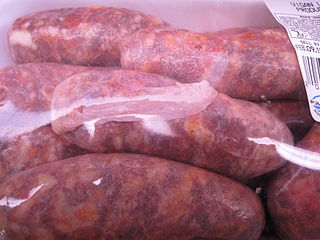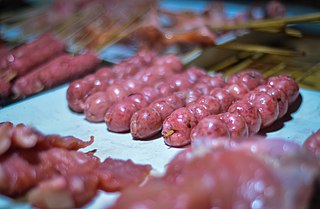
Pampanga, officially the Province of Pampanga, is a province in the Central Luzon region of the Philippines. Lying on the northern shore of Manila Bay, Pampanga is bordered by Tarlac to the north, Nueva Ecija to the northeast, Bulacan to the east, Manila Bay to the central-south, Bataan to the southwest and Zambales to the west. Its capital is the City of San Fernando. Angeles City is the largest LGU, but while geographically within Pampanga, it is classified as a first-class, highly urbanized city and has been governed independently of the province since it received its charter in 1964.

The Pampanga River is the second largest river on the island of Luzon in the Philippines and the country's fifth longest river. It is in the Central Luzon region and traverses the provinces of Pampanga, Bulacan, and Nueva Ecija.

Calumpit, officially the Municipality of Calumpit, is a 1st class municipality in the province of Bulacan, Philippines. According to the 2020 census, it has a population of 118,471 people.

Longaniza is a Spanish sausage (embutido) similar to a chorizo and also closely associated with the Portuguese linguiça. Its defining characteristics are interpreted differently from region to region. It is popular in the cuisines of several regions of Spain, Argentina, Uruguay, Puerto Rico, Dominican Republic, El Salvador, Guatemala, Mexico and Chile. In the Philippines, it is called longganisa and has hundreds of variants with different vernacular tastes and forms due to the 144 ethno-linguistic groups of the archipelago. Longaniza essentially tracks the spread of Latin culture around the world. Longaniza derives from Lucanica, a sausage from Lucania in Southern Italy that was adopted by the Latins of Ancient Rome through military contact. From there it spread to Spain, and from Spain, centuries later, to every place in the world with modern "Latin" culture.

Pampanga lies within the Central Plain region and has a total land area of 2,180.70 square kilometers. Together with Bulacan, Nueva Ecija, Pangasinan and Tarlac, the region includes a total area of approximately 5,900 square miles, mostly composed of lowlands and arable areas.
Alaminos longganisa, also known as longganisa Pangasian, is a Filipino pork sausage originating from Alaminos, Pangasinan. It is a type of de recadolongganisa. It is made with ground lean pork, ground pork fat, brown sugar, coarse salt, saltpeter, black pepper, bay leaf, vinegar, and garlic in hog casings. It is slightly sour, garlicky taste, typically bright yellow or orange due to the use of achuete seeds, made in bite-sized pieces. It is a popular pasalubong.

Vigan longganisa, also known as the Ilocano longganisa, is a Filipino pork sausage originating from Vigan City, Ilocos Sur. It is a type of de recadolongganisa noted for its salty, garlicky, and sour flavor. It is air-dried, made with ground lean pork, annatto, coarsely ground pork and fat, brown sugar, garlic, onions, bay leaves, soy sauce, vinegar, black pepper, and salt to taste in hog casings. Chili flakes may also be added. The sausages are celebrated in an annual "Longganisa Festival" in Vigan City.

Chorizo de Macao, sometimes called Chinese Chorizo or Longaniza Macau, is a Filipino dry pork sausage. The ingredients of Chorizo de Macao is identical to other Filipino sweet longganisas, except for its dry texture and its use of star anise, aniseed, or anise liqueur (anisado), which gives it its distinctive aroma and its name. It is commonly used in Chinese Filipino dishes like pancit Canton and siopao. It is sometimes confused with and used in place of Chinese sausage.

Chorizo de Cebu, also known as longganisa de Cebu, is a Filipino pork sausage originating from Cebu. It is a type of hamonada (sweet) longganisa. They are distinctively red in color due to the use of achuete seeds. Each link is also usually spherical in shape. It is made from ground lean pork, ground pork fat, salt, saltpeter, sugar, anise liqueur (anisado), paprika, black pepper, garlic, and chilis to taste in a hog casing. It can also be made without the casing. They are usually fried or grilled and eaten with white rice, puso, or garlic rice for breakfast.
Longganisa de Guinobatan is a Filipino pork sausage originating from the town of Guinobatan in Albay, Philippines. It is a type of de recadolongganisa. Each link is typically only 2 inches (5.1 cm) in length. It is made from lean pork, pork fat, salt, sugar, garlic, saltpeter, and black pepper. Unlike other Philippine sausages, the meat is uniquely chopped by hand. The dish is celebrated in the annual "Longganisa Festival" of Guinobatan.
Cabanatuan longganisa, also known as batutay, bototay, or batotay, depending on the municipality, is a Filipino beef sausage originating from Cabanatuan in the province of Nueva Ecija. It can be served sweet (hamonado), garlicky, or "skinless". It is celebrated in the annual "Longganisa Festival" of Cabanatuan.

Calumpit longganisa, also known as longganisang bawang, is a Filipino pork sausage originating from Calumpit, Bulacan, Philippines. It is a type of de recadolongganisa. It is made with lean pork, pork fat, garlic, bay leaves, brown sugar, soy sauce, vinegar, salt, black pepper, paprika, and optionally, chili.

Pampanga longganisa is a Filipino pork sausage originating from the province of Pampanga. It is a type of hamonado (sweet) longganisa. It is typically longer and thinner than other Philippine sausages. It is made with pork, garlic, brown sugar, black pepper, coarse salt, and vinegar. It can be prepared with or without the casing. It is typically dyed orange or red with achuete seeds. It is the most common sweet-type longganisa eaten throughout the Philippines, since it is commercially mass-produced.

Lucban longganisa is a Filipino pork sausage originating from Lucban, Quezon. It is a type of de recadolongganisa. It is characterized by its use of oregano and its garlicky and sour taste. It is made with coarse and lean pork, pork fat, coarse salt, onions, garlic, oregano, paprika, peppercorns, sugar, and vinegar. It can be prepared with or without the sausage casing.
Tuguegarao longganisa, also known as the Ybanag longganisa, is a Filipino pork sausage originating from the Ybanag people of Tuguegarao City, Cagayan. It is a type of de recadolongganisa. It is made with coarsely ground pork, black pepper, garlic, coarse salt, and cane vinegar in hog casings. It is typically dyed orange with achuete oil.

Chicken longganisa is a Filipino fresh sausage made with minced chicken meat, garlic, onion, soy sauce, muscovado sugar, salt, vinegar, and black pepper. Vegetable extenders can also be added like carrots, turnips, or jicamas. It is sold as a healthier alternative to other kinds of longganisa. It is usually prepared without the casing ("skinless"), and is molded into shape with the use of wax paper.
Fish longganisa, or fish chorizo, is a Filipino sausage made with fish instead of pork or beef. It is typically made from tuna, tilapia, or milkfish. It is prepared identically to other Filipino longganisa and is marketed as a healthier alternative. It may use regular pork casings, vegetable-based casings, or be prepared "skinless".
Baguio longganisa is a Filipino pork sausage originating from the city of Baguio. It is a type of hamonado (sweet) longganisa.

Pampanga's 2nd congressional district is one of the four congressional districts of the Philippines in the province of Pampanga. It has been represented in the House of Representatives of the Philippines since 1916 and earlier in the Philippine Assembly from 1907 to 1916. The district consists of the western Pampanga municipalities of Floridablanca, Guagua, Lubao, Porac, Santa Rita and Sasmuan. It is currently represented in the 19th Congress by Gloria Macapagal-Arroyo of the Lakas–CMD (Lakas).
Pampanga in the Philippine Revolution remained almost wholly loyal to Spanish suzerainty, with only few noble Kapampangan families defecting to the Katipunan. Kapampangan involvement in defending Spanish interests began when the Revolution broke out, with many freemen enlisting in Spanish forces. However, Tagalog rebels would eventually infiltrate the province and begin a campaign of terrorism. Once Spain lost the Battle of Manila Bay, Spanish forces in Pampanga retreated to Macabebe and awaited their return to Spain. Republican forces would raze and loot Kapampangan towns for their cooperation with Spanish forces. To revenge their losses, many Kapampangans would enlist with the Americans to defeat the Philippine Republic.














